



Suggested Citation: Khalid, Wase, Abhishek Jain, Selna Saji and Sharath Rao. 2023. Decentralised Renewable Energy for SDG7:A Compendium of Global Good Practices. New Delhi: Council on Energy, Environment and Water.
This compendium meticulously identifies and collates the emerging good practices to mainstream Decentralised Renewable Energy (DRE) solutions. Envisioned as a ‘practitioners’ guide’ for the public- and private sector leaders, it synthesises ‘replicable and actionable lessons’ to fast-track DRE deployment for achieving the SDGs.
A just and inclusive global energy transition is incomplete without universal energy access. At the current pace of progress, the IEA estimates that 660 million people in the Global South will still lack electricity access by 2030 – the year targeted to achieve the Sustainable Development Goals (SDGs) (IEA 2022). DRE offers faster and more cost-effective solutions to increasing electricity access in rural or remote areas with lower population densities. Additionally, meeting the energy demand of emerging economies via renewable sources allows for a ‘double leapfrog’ towards energy access and clean energy (Jain et al. 2021). Thus, it is essential to recognise and mainstream DRE in order to realise a citizen-centric global energy transition.
A just and inclusive global energy transition is incomplete without universal energy access. At the current pace of progress, the IEA estimates that 660 million people in the Global South will still lack electricity access by 2030 – the year targeted to achieve the Sustainable Development Goals (SDGs) (IEA 2022b). Even as the centralised grids expand, decentralised renewable energy (DRE) is playing a significant role in bridging the energy access gap, both as an alternative and as complimentary to centralised grid systems. In 2021 alone, 179 million people gained access to electricity from DRE solutions - up from 35 million in 2012 (IRENA 2022a). DRE offers faster and more cost-effective solutions to increasing electricity access in rural or remote areas with lower population densities. Additionally, meeting the energy demand of emerging economies via renewable sources allows for a ‘double leapfrog’ towards energy access and clean energy (Jain et al. 2021). Thus, it is essential to recognise and mainstream DRE in order to realise a citizen-centric global energy transition.
The compendium meticulously identifies and collates the emerging good practices to mainstream DRE solutions. Envisioned as a ‘practitioners’ guide’ for the public and private sector leaders, it synthesises ‘replicable and actionable lessons’ to fast-track DRE deployment for achieving the SDGs.
The compendium employs a literature review, multi-stage case selection, and ‘inductive reasoning’ to identify and analyse DRE good practices. More than 120 DRE case studies were identified across the globe through a snowballing technique. Multi-stage shortlisting criteria led to the final selection of 27 DRE case studies spanning 5 continents, 22 countries, and 10+ DRE intervention categories.
The good practices span five core areas that are most critical for igniting and growing the DRE sector in any region of the globe. These include an enabling policy environment, active community engagement, accessible and affordable financing, a thriving market ecosystem, and a conducive environment for innovations.
An enabling policy environment often forms the basis for the adoption and scaling-up of DRE interventions, given the high upfront costs and perceived risks. The policy environment should aim to achieve one or more of the following three objectives: providing long-term policy certainty, the flexibility to encourage innovation and adapt as the market grows and new challenges arise, and ensuring effective implementation. Several good practices to create an enabling policy environment have been identified from the case studies, which help implementing countries in achieving these objectives, and, thus, lead to the successful adoption of the intended DRE technology among the beneficiaries. The most common five good practices are listed below:
Figure ES1 Summary of emerging good practices for creating an enabling policy environment.
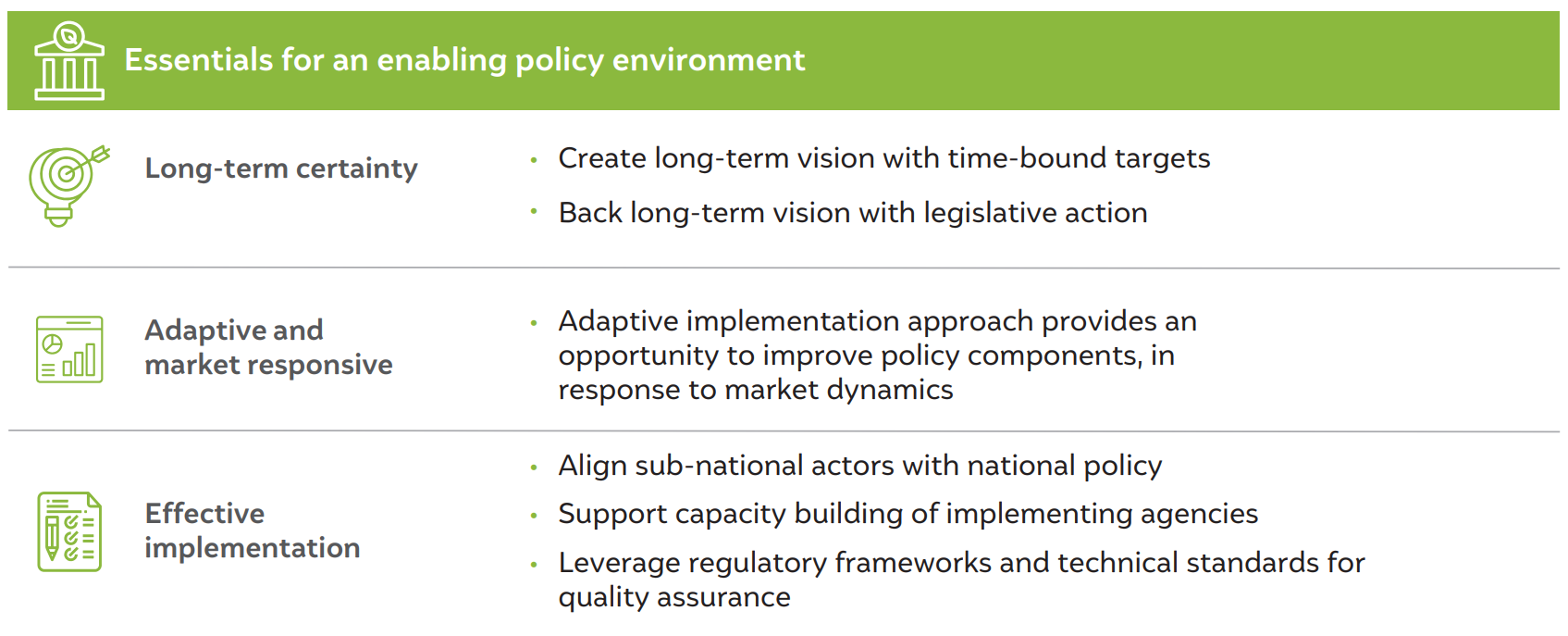
Source: Authors' analysis
In order to ensure a citizen-centric approach to the energy transition, community engagement is a critical part of DRE interventions. The analysis reveals three levels of community engagement beyond stakeholder consultations that can be adopted to achieve higher community participation. These include total buy-in from the community, a sense of ownership among the community members, and nurturing community leadership. The most recurring good practices that can further these objectives are:
Figure ES2 Summary of emerging good practices for active community engagement.
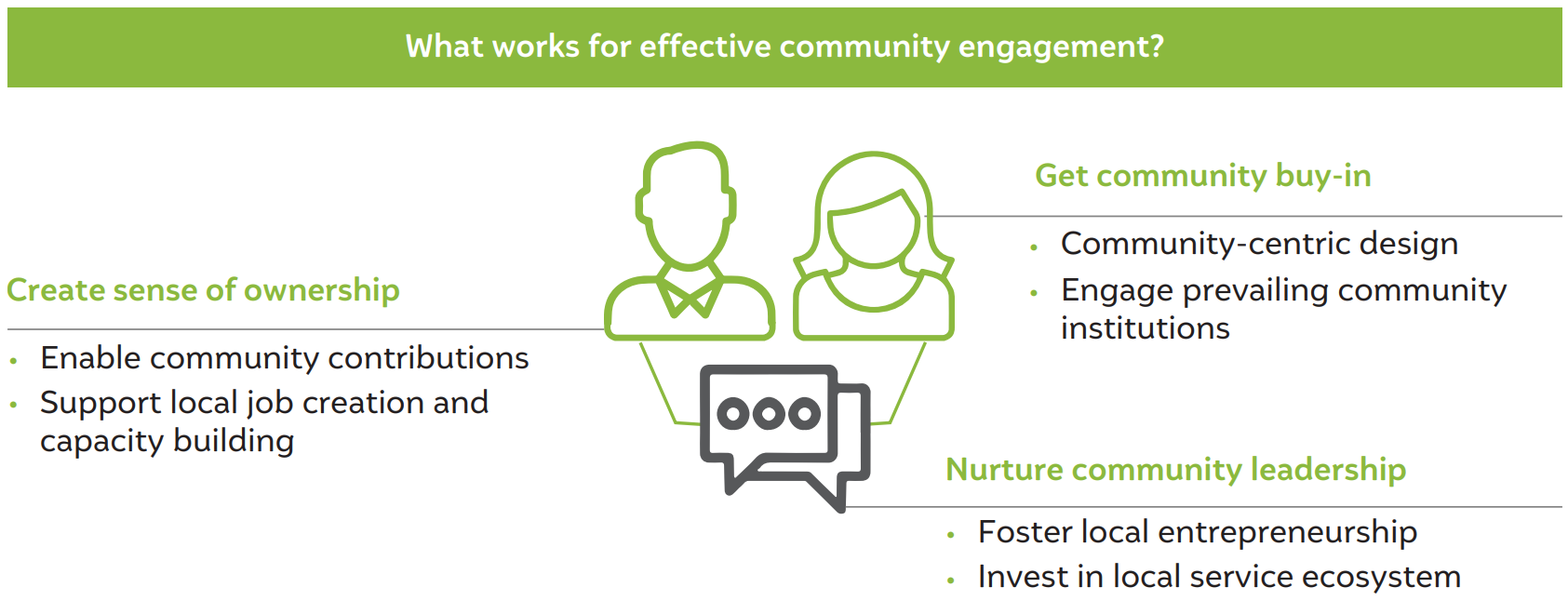
Source: Authors' analysis
Figure ES3 Summary of emerging good practices for providing accessible and affordable financing.

Source: Authors' analysis
The adoption of DRE solutions is hindered by their substantial initial investment requirements. Access to affordable financing is essential at the programme, project, and individual-user levels. The case studies show that financing interventions have two common objectives: creating accessible financing options for the targeted beneficiaries and reducing the financing cost, especially initial investment costs. Good practices that can achieve either or both of these objectives are:
Figure ES4 Summary of emerging good practices on thriving market ecosystem.
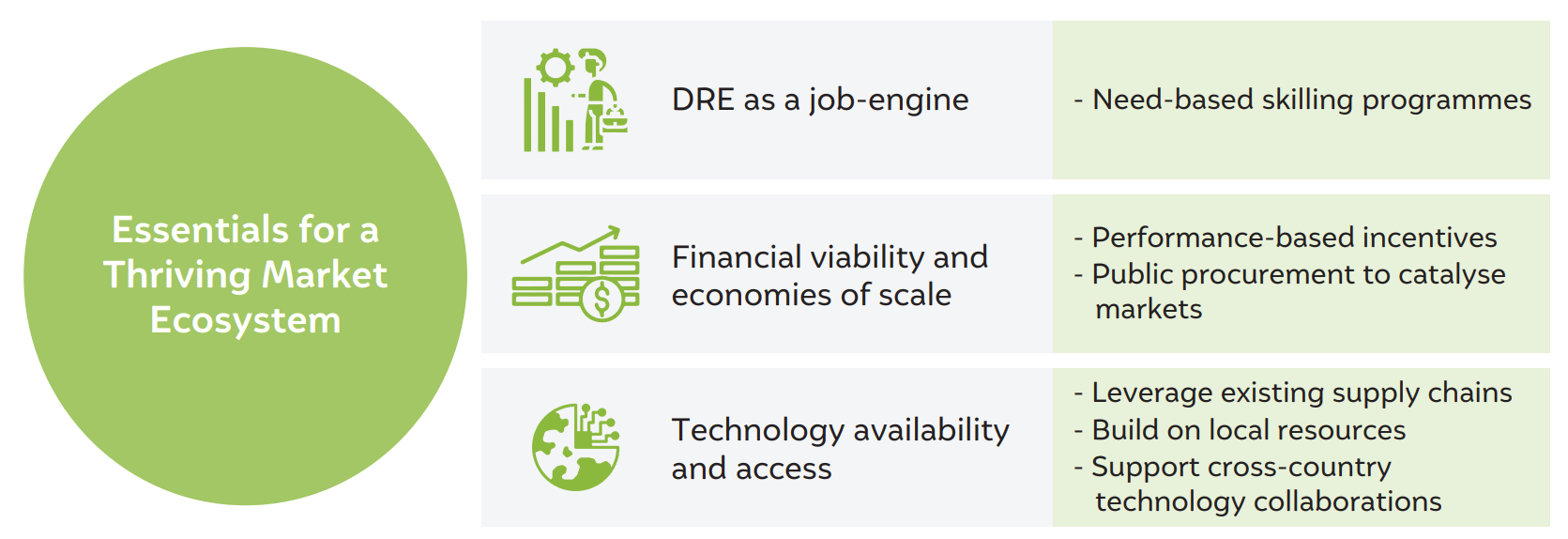
Source: Authors' analysis
A thriving market ecosystem that supports DRE technology is essential for achieving adoption at scale and long-term sustenance. Such a market system requires ensuring skilled resource availability, financial viability, access to markets, revenue generation opportunities, and availability and access to the latest cost-effective technologies. This enables greater consumer choice and better services for citizens. The good practices that are effective in enabling thriving market ecosystem conditions are:
Figure ES5 Summary of emerging good practices on conducive environment for innovation.
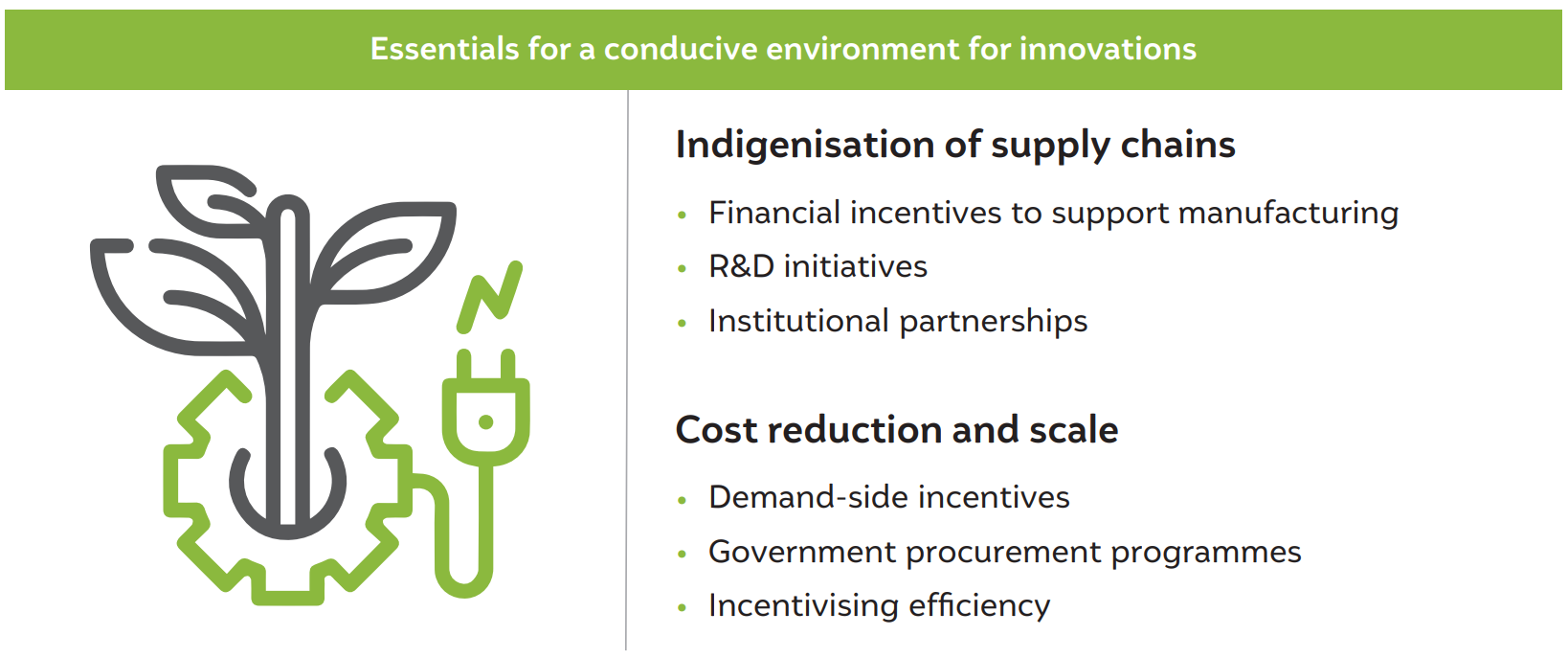
Source: Authors' analysis
DRE is an emerging sector with many innovation opportunities on the technological, business, and financial fronts. A conducive environment for innovation can help reduce costs, enhance technology resilience, and create local economic opportunities. Two successful good practices to create a conducive innovation environment are:
The analysis of DRE case studies around the globe has shown that there are similarities in the nature of challenges, particularly in the Global South, and that there is vast potential to learn from cross-country experiences. The good practices observed around policy, community engagement, financing, markets, and innovation may serve as an effective guide to designing new DRE interventions for policymakers, private players, and civil society. Based on these observations, the following recommendations are put forth:
Progress has been made in improving electricity access and achieving universal energy access; as of 2020, almost 91 percent of global population have access to electricity (ESMAP 2022). However, we are not on-track to meet the 2030 goal and the progress has been uneven (IEA 2022c). The progress has been particularly impeded in vulnerable regions, such as sub-Saharan Africa, where the number of people without access continues to alarmingly grow (IEA 2022c). One of the key levers that can help achieve this goal are DRE solutions that are increasingly costeffective and easy to deploy, leverage local resources, can be tailored to uses across residential, productive use and institutional applications, and are environmentally sustainable. Meeting the energy needs, therefore, through DRE helps meet multiple objectives.
While DRE has been around for a while, the sector is rapidly evolving with technological, business, market, and policy innovations. The effort of the compendium, which is a ‘practitioners’ guide on good practices’, is to showcase practices that can be replicated by planning agencies and help leaders and influencers in the public and private sectors mainstream DRE for achieving the SDGs. This practitioners’ guide attempts to compile and synthesise best practices from a wide variety of DRE interventions across the globe. If adopted at scale, DRE can help the G20 and other developing countries achieve more environmentally sustainable economic and job growth.
Different studies in the DRE sector mention policy, finance, community, capacity building, market, infrastructure, technology, and institutional engagements as being core to enabling the deployment of DRE solutions (IRENA 2022, WWF-India and SELCO Foundation 2015, CLEAN 2021). Accordingly, we have captured the DRE ‘good practices’ by deep-diving into five core elements that are consistently considered by the literature and experts as the most critical elements for igniting transition and transformation and promoting a thriving DRE sector in any region. These are, an enabling policy environment, active community engagement, accessible and affordable financing, athriving market ecosystem, and a conducive environment for innovations.
G20 countries should support avenues for the active sharing of knowledge and lessons from DRE experiences to fast-track DRE deployments in the Global South. A key takeaway from the DRE case studies is that the challenges that impede DRE adoption remain similar across geographies to an extent. For example, diverse financing tools and mechanisms have been adopted by different countries to address the common challenge of affordable financing. These include PAYGO in Kenya, blended finance in India, and carbon emission reduction certificates in South Africa, among others. Accordingly, a lot can be learned from experiences across countries. Higher levels of global cooperation and partnerships for knowledge sharing can usher in a new era for DRE.
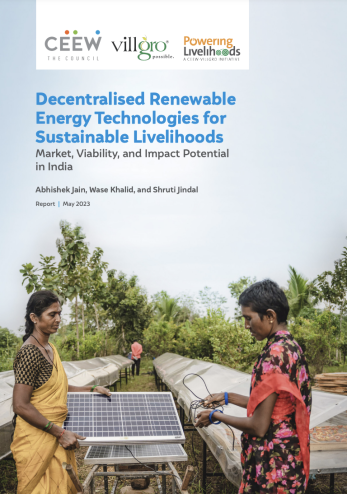
Decentralised Renewable Energy Technologies for Sustainable Livelihoods
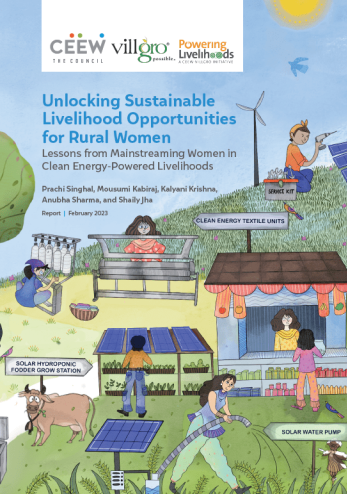
Unlocking Sustainable Livelihood Opportunities for Rural Women
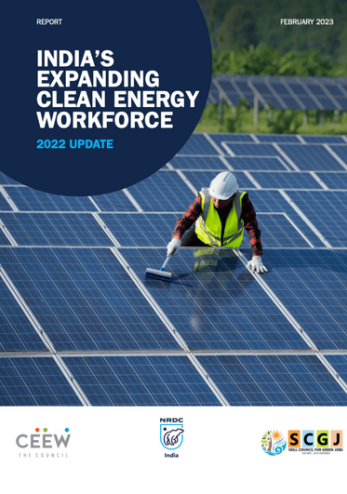
India's Expanding Clean Energy Workforce 2022 Update